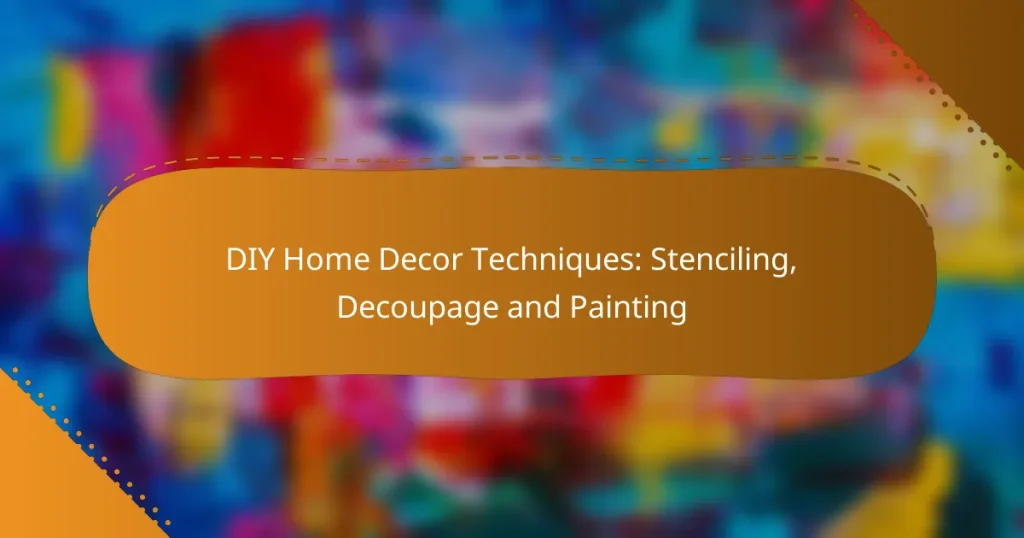DIY home decor techniques such as stenciling, decoupage, and painting offer creative ways to personalize and enhance your living space. Stenciling allows for intricate designs using templates, while decoupage transforms ordinary items with decorative paper cutouts. Additionally, various painting techniques can add depth and character, making it easy to reflect your unique style in your home.

How can I use stenciling in DIY home decor?
Stenciling is a versatile technique in DIY home decor that allows you to create intricate designs on various surfaces. It involves applying paint through a cut-out template to achieve patterns or images, making it a cost-effective way to enhance your space.
Stenciling techniques for walls
When stenciling walls, start by selecting a design that complements your room’s theme. Use painter’s tape to secure the stencil and prevent paint bleed. Apply paint with a sponge or brush, using a dabbing motion for even coverage.
Consider using a spray adhesive on the back of the stencil to keep it in place. For larger areas, work in sections and allow each section to dry before moving on to the next to ensure clean lines.
Best stencils for furniture
For furniture, opt for durable stencils made from materials like mylar or plastic, which can withstand the wear and tear of everyday use. Choose designs that fit the style of the piece, whether it’s modern, vintage, or rustic.
Before stenciling, clean the surface thoroughly and apply a primer if necessary. Use a small brush or foam applicator for detailed work, and seal the finished design with a clear coat to protect it from scratches and fading.
Popular stencil designs
Popular stencil designs include geometric patterns, floral motifs, and inspirational quotes. Geometric shapes can add a contemporary touch, while floral patterns bring a classic feel to your decor.
Consider seasonal themes or personalized designs to make your decor unique. You can find ready-made stencils at craft stores or create your own using a cutting machine for a custom look.

What are the benefits of decoupage in home decor?
Decoupage offers a creative way to personalize home decor by applying decorative paper cutouts to various surfaces. This technique allows for unique designs, enhances aesthetics, and can transform ordinary items into eye-catching focal points.
Decoupage on furniture
Decoupaging furniture can breathe new life into old pieces, making them stylish and unique. Consider applying cutouts of fabric, wallpaper, or decorative paper to tabletops, chairs, or cabinets for a fresh look. Ensure the surface is clean and smooth, and use a strong adhesive to secure the paper.
When decoupaging furniture, it’s essential to seal the finished piece with a clear varnish or sealant to protect it from wear and tear. This not only preserves the design but also adds a glossy finish that enhances the overall appearance.
Decoupage for wall art
Decoupage can also be used to create stunning wall art, allowing you to customize your living space easily. You can use canvases or wooden boards as a base and layer various images or patterns to create a collage effect. This approach is perfect for showcasing personal memories or artistic themes.
To achieve the best results, consider using high-quality images and a strong adhesive. After applying the cutouts, finish with a protective coat to ensure durability and maintain the vibrancy of the colors.
Materials needed for decoupage
To start decoupaging, gather essential materials such as decorative paper, scissors, a brush, and a suitable adhesive like Mod Podge. You may also need a clear sealant for finishing touches, depending on the project.
- Decorative paper (napkins, scrapbook paper, or fabric)
- Adhesive (Mod Podge or PVA glue)
- Brush or sponge for application
- Scissors for cutting
- Sealant for protection (optional)
Having these materials on hand will streamline your decoupage projects and help you achieve professional-looking results.

What painting techniques enhance home decor?
Painting techniques can significantly elevate home decor by adding depth, character, and personalization to spaces. Techniques like stenciling, sponging, and color washing allow homeowners to create unique designs that reflect their style and enhance the overall aesthetic of their interiors.
Popular painting styles
Among the most popular painting styles are modern, rustic, and vintage. Modern styles often feature bold colors and clean lines, while rustic styles embrace natural tones and textures. Vintage styles incorporate soft pastels and distressed finishes, creating a nostalgic feel.
Accent walls are a common application of these styles, where a single wall is painted in a contrasting color or pattern to create a focal point in a room. This technique is effective in living rooms, bedrooms, and even kitchens.
Best paint types for DIY projects
For DIY projects, latex paint is often recommended due to its ease of use and quick drying time. It is water-based, making it easy to clean up, and is available in a variety of finishes, from matte to glossy.
For surfaces that require durability, such as kitchens and bathrooms, consider using semi-gloss or satin finishes. These types resist moisture and are easier to wipe clean, making them practical choices for high-traffic areas.
Techniques for achieving texture
Textured finishes can be achieved through various techniques, such as sponging, rag rolling, or using a brush to create patterns. Sponging involves applying a base coat and then using a sponge to add a contrasting color, resulting in a soft, mottled effect.
Another popular method is the use of a textured roller, which can create patterns like waves or stripes. This technique is particularly effective for adding interest to large wall areas without overwhelming the space.

What tools do I need for DIY home decor projects?
For DIY home decor projects, essential tools vary based on the technique you choose. Generally, you’ll need basic crafting supplies, specific tools for stenciling, decoupage materials, and painting equipment to achieve the desired results.
Essential stenciling tools
Stenciling requires a few key tools to ensure clean and precise designs. Start with a stencil of your choice, which can be purchased or made from materials like plastic or cardboard. A good quality stencil brush or sponge is crucial for applying paint without bleeding under the stencil edges.
Additionally, consider using painter’s tape to secure the stencil in place and prevent movement. A craft knife can help you create custom stencils or clean up edges if needed. Always test your stencil on scrap material before applying it to your final surface.
Decoupage supplies
For decoupage, you’ll need a few specific supplies to adhere paper or fabric to surfaces. The primary material is decoupage glue, which acts as both adhesive and sealant. Popular brands include Mod Podge or homemade versions using equal parts water and white glue.
You’ll also need scissors for cutting your chosen images or materials, and a brush or sponge to apply the glue evenly. Consider using a clear acrylic sealer for added durability once your project is complete, especially for items that will be handled frequently.
Painting equipment checklist
When painting for home decor, having the right equipment is essential for a smooth finish. Basic items include high-quality paintbrushes, rollers, and painter’s tape to protect areas you don’t want to paint. Choose paint suited for your project, such as acrylic for crafts or latex for walls.
Don’t forget drop cloths to protect your floors and furniture, as well as a paint tray for easy access. If you’re working on larger surfaces, consider a paint sprayer for a more uniform application. Always follow safety guidelines, such as using masks and ventilating your workspace when working with strong fumes.

How do I choose the right colors for my decor?
Choosing the right colors for your decor involves understanding color theory, current trends, and utilizing effective tools. Start by considering the mood you want to create and how different colors interact with each other.
Color theory basics
Color theory is the foundation of choosing the right colors for your decor. It includes concepts like the color wheel, which illustrates primary, secondary, and tertiary colors, and how they relate to each other. Complementary colors, which are opposite each other on the wheel, create contrast, while analogous colors, which are next to each other, provide harmony.
When selecting colors, consider the psychological effects they can have. For instance, blues and greens are calming, while reds and yellows can energize a space. Understanding these basics can help you create a balanced and inviting atmosphere.
Trendy color palettes
Staying updated with trendy color palettes can enhance your decor’s appeal. Popular palettes often include combinations like earthy tones with pops of vibrant colors or monochromatic schemes that use varying shades of a single color. Websites and design magazines frequently showcase these trends, providing inspiration for your projects.
For example, the use of soft pastels has gained traction in recent years, creating a serene environment. Alternatively, bold jewel tones can add a touch of luxury and sophistication. Choose a palette that resonates with your personal style while also fitting the overall theme of your home.
Tools for color selection
Several tools can assist you in selecting the right colors for your decor. Color swatches and sample paint pots allow you to see how colors look in your space under different lighting conditions. Digital tools and apps can also help visualize color combinations before making a commitment.
Additionally, consider using color-matching tools available at paint stores, which can suggest complementary shades based on your chosen color. This can simplify the decision-making process and ensure a cohesive look throughout your home.

What are the best practices for DIY home decor?
Best practices for DIY home decor involve careful planning, adherence to safety guidelines, and awareness of common pitfalls. By following these practices, you can create beautiful and functional spaces while minimizing risks and mistakes.
Planning your project
Effective planning is crucial for a successful DIY home decor project. Start by defining your goals, such as the specific look you want to achieve or the functionality you need. Create a budget that includes materials, tools, and any professional help you might require.
Next, gather inspiration from various sources like magazines, websites, or social media. Make a list of the materials you’ll need and sketch out your design to visualize the final outcome. This preparation will help you stay organized and focused throughout the process.
Safety tips for DIY projects
Safety should always be a priority when undertaking DIY home decor projects. Wear appropriate personal protective equipment (PPE), such as gloves, goggles, and masks, especially when working with paints, adhesives, or power tools. Ensure your workspace is well-ventilated to avoid inhaling harmful fumes.
Familiarize yourself with the tools you will be using and follow the manufacturer’s instructions. Keep a first aid kit nearby in case of minor injuries, and never hesitate to ask for help if you’re unsure about a task. Safety precautions can prevent accidents and ensure a smoother project experience.
Common mistakes to avoid
One common mistake in DIY home decor is underestimating the time and effort required for a project. Always allocate extra time for unexpected challenges and allow for drying or curing times when using paints or adhesives. Rushing can lead to poor results and frustration.
Another frequent pitfall is failing to measure accurately. Always double-check your measurements before cutting materials or purchasing items. Additionally, avoid choosing colors or patterns without testing samples first, as they may look different in your space than they do in the store.


